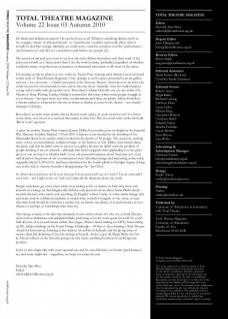Do labels and definitions matter? On one level, not at all. Whether something defines itself as, for example, ‘mime’ or ‘physical theatre’ or ‘visual theatre’ wouldn’t necessarily affect what it actually looked like onstage. Similarly, we could worry ourselves senseless over the ‘performance’, ‘performance art’ and ‘live art’ conundrum (and believe me, people do).
My usual kool-aid acid test is just to see how the artist defines themselves and their work: if the artist sees herself as a ‘dance artist’ then I see the work as dance (probably), regardless of whether it includes music or spoken text or narrative or abstracted movement or all/none of the above.
I’m musing on this in relation to two works by Turner Prize winning artist Martin Creed (reviewed in this issue of Total Theatre Magazine). One, perhaps as we’d expect, presented at an art gallery, and one – less obviously – a ‘ballet’ presented at the Traverse Theatre. And why not? An artist can surely choose his own materials to suit, and in this case those ‘materials’ were five ballet dancers, a stage and an indie rock group (his own). Then there’s Adrian Howells’ one-on-one works (The Pleasure of Being: Washing, Feeding, Holding is reviewed in this issue) which some people struggle to see as theatre – but apart from any other considerations, and there are plenty, Adrian Howells is a theatre-maker so whatever he chooses to frame as theatre is, in my book, theatre – not ‘merely’ massage or therapy.
But what if an artist states clearly that he doesn’t want a piece of work viewed as art? Is it down to the artist, or is it how it is received that makes it what it is? This is a novel twist on the tired old ‘But is it art?’ question.
A piece by another Turner Prize winner, Jeremy Deller, has recently gone on display at the Imperial War Museum. Entitled Baghdad, 5 March 2007 it features a car wrecked in the bombing of the Mutanabbi Street book market, which resulted in the deaths of 38 people. The actual car, nothing more or less: an extraordinary sculptural image of the horrors of war. Deller, interviewed about the piece, said that he didn’t want to show it in a gallery because he didn’t want the problem of people thinking it was an artwork – although that hasn’t stopped critics applauding it as the great piece of war art that it is. Double bluff to see off potential bad press about ‘bad taste art’, or an odd denial of the power of art to comment on war? All rather strange and interesting as the work, originally titled It Is What It Is, had been shortlisted for the fourth plinth in Trafalgar Square (losing out, in the end, to Antony Gormley’s disappointing One And Other).
So where does that leave us? Is it art because I’m an artist and I say so? And if I’m an artist and I say it isn’t – am I right to do so? And can I make all the decisions about my work?
People sometimes get cross when artists stop making work, or destroy or hide away their own artwork or writings (as Ted Hughes did with the only poem he wrote about Sylvia Plath’s death – recently released, after much soul-searching, by Hughes’ widow Carol); or when artists change tack and make work in a different medium; or switch from comedy to tragedy or vice versa; or state that their work should be viewed in a certain way (as theatre not dance; or as performance art not theatre; or perhaps as something other than art).
This brings us back to the idea that ultimately it’s the artist’s choice. It’s why we, at Total Theatre, resist narrow definitions and unhelpful labels, preferring to let the work speak for itself. So you’ll find all sorts of ways and means within these pages. There’s bread-making (at LIFT), horse-riding (at IF), ladder-climbing (at the Forest Fringe, Edinburgh – 30 Days to Space winning a Total Theatre Award for Innovation), loitering at bus stations (at artFart in Iceland), and the giving away of money (Sara Juli disposing of her life-savings at Sacred). And to cap it all, Pippa Bailey (in Out & About) reflects on the heavenly goings-on that outdo anything theatrical we earthlings can produce.
Some of this might tally with your expectations, and fit your definition, of theatre/performance/ art, and some might not – regardless, we hope you enjoy the mix.

